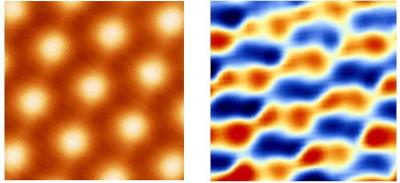A research team led by Rutgers University has discovered that in the presence of a moiré pattern in graphene, electrons organize themselves into stripes, like soldiers in formation. The team's findings could help in the search for quantum materials, such as superconductors, that would work at room temperature. Such materials would dramatically reduce energy consumption by making power transmission and electronic devices more efficient.
 Left: image shows a moiré pattern in "magic angle" twisted bilayer graphene. Right: Scanning tunneling charge spectroscopy, shows correlated electrons. Credit: Rutgers University
Left: image shows a moiré pattern in "magic angle" twisted bilayer graphene. Right: Scanning tunneling charge spectroscopy, shows correlated electrons. Credit: Rutgers University
"Our findings provide an essential clue to the mystery connecting a form of graphene, called twisted bilayer graphene, to superconductors that could work at room temperature," said senior author Eva Y. Andrei, Board of Governors professor in the Department of Physics and Astronomy in the School of Arts and Sciences at Rutgers UniversityNew Brunswick.
In 2010, Andrei's team discovered that moiré patterns formed with twisted bilayer graphene have a dramatic effect on the electronic properties of the material. This is because the moiré pattern slows down the electrons that conduct electricity in graphene and zip past each other at great speeds.
At a twist angle of about 1.1 degreesâthe so-called magic angleâthese electrons come to an almost dead stop. The sluggish electrons start seeing each other and interact with their neighbors to move in lock-step. As a result, the material gains remarkable properties such as superconductivity or magnetism.
Using a technique invented by Andrei's group to study twisted bilayer graphene, the team discovered a state where the electrons organize themselves into stripes that are robust and difficult to break.
"Our team found a close resemblance between this feature and similar observations in high-temperature superconductors, providing new evidence of the deep link underlying these systems and opening the way to unraveling their enduring mystery," Andrei said.